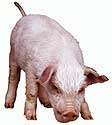
THURSDAY, June 17 (HealthDay News) — Although the pandemic H1N1 “swine” flu that emerged last spring has stayed genetically stable in humans, researchers in Asia say the virus has undergone genetic changes in pigs during the last year and a half.
The fear is that these genetic changes, or reassortments, could produce a more virulent bug.
“The particular reassortment we found is not itself likely to be of major human health risk, [but] it is an indication of what may be occurring on a wider scale, undetected,” said Malik Peiris, an influenza expert and co-author of a paper published in the June 18 issue of Science. “Other reassortments may occur, some of which pose greater risks.”
The findings underscore the importance of monitoring how the influenza virus behaves in pigs, said Peiris, who is chair and professor of microbiology at the University of Hong Kong and scientific director of the university’s Pasteur Research Center.
“Obviously, there’s a lot of evolution going on and whenever you see some unstable situation, there’s the potential for something new to emerge that could be dangerous,” added Dr. John Treanor, professor of medicine and of microbiology and immunology at the University of Rochester Medical Center in New York.
The novel H1N1 pandemic influenza virus that began circulating in humans in early 2009 originally came from swine, first infecting humans in Mexico before spreading to more than 200 countries.
In humans, the 2009 H1N1 virus has stayed genetically the same and still causes relatively mild disease, when it causes disease at all (the virus has all but disappeared in recent weeks, although experts suspect it will be back).
But in January 2010, the authors of this paper isolated a new version of the H1N1 virus in pigs in a Hong Kong slaughterhouse.
The H1N1 virus circulating in humans apparently looped back to pigs, where it underwent this genetic change. Theoretically, the changed virus could now hop back to humans, potentially causing more dangerous disease.
“We found that the pandemic virus has repeatedly transmitted back to pigs, and we report one instance of reassortment, meaning genetic change, of this virus within pigs,” said Peiris.
Peiris and his co-authors pointed out that the influenza viruses that sparked the 1918, 1957 and 1968 pandemics all lingered in mammals before reassorting and wreaking havoc on humans.
“Our point is that this is likely to be occurring in many places and not unique to Hong Kong,” Peiris said. “There is need for much greater surveillance efforts to assess what is occurring on a worldwide basis.”
“In the past, we have focused a lot of attention trying to understand what’s been going on in birds,” Treanor said. “This article and others are saying it may be equally or more important to have extensive surveillance of viruses in pigs.”
More information
The U.S. Centers for Disease Control and Prevention has more on H1N1.

